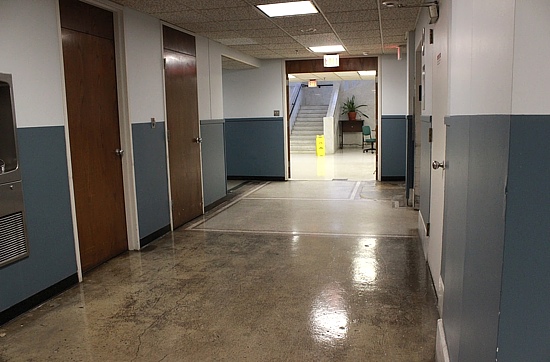General Assembly building new offices
The asbestos-laden, mold-infested, leaky office building of the Virginia General Assembly will be replaced by a new building set to open for the 2020 session.

By Lauren McClellan | Capital News Service
The asbestos-laden, mold-infested, leaky office building of the Virginia General Assembly will be replaced by a new building set to open for the 2020 session.
The state budget includes $300 million in revenue bonds to replace the General Assembly office building along with the restoration of historic Old City Hall. This money also will be used to build a 500-space parking deck at North Ninth and East Broad streets.
During construction, the offices will move to the Pocahontas Building at the south of Capitol Square in 2016. Old City Hall restoration and the building of the new parking deck will be completed in 2018.
In 2019, the new General Assembly office building is scheduled to be completed in time for the 2020 session.
Dr. Kevin Cooper, professor of pulmonary and critical care medicine at the Medical College of Virginia at Virginia Commonwealth University, says being exposed to asbestos can cause people to develop mesothelioma, a cancer that can form in the lining of internal organs. According to Cooper, the risk of developing the lung cancer mesothelioma is low.
“(Being exposed to asbestos) is a very small danger of a very serious possible problem,” Cooper said. “People who have not very much exposure (to asbestos) can get mesothelioma. The numerical risk of that happening is extremely small.”
Even though the risk of contracting mesothelioma is small, Cooper still says it is still a critical issue.
“It’s best, since so many millions of people are in areas where asbestos is being removed or is still present,” Cooper said, “that they do everything reasonable to avoid contact with it.”
Preservation Virginia, a non-profit organization dedicated to preserving Virginia’s history, has been monitoring the developments of the new General Assembly construction project.
Preservation Virginia’s Director of Preservation Initiatives and Engagement Justin Sarafin says this is not the first time there have been talks to change the office building.
“We rallied with other preservation groups in 2005 and 2006 to find planning tools that would preserve the 8th and 9th street office buildings, formerly the Murphy and Richmond Hotels,” Sarafin said. “The 9th Street building is being rehabbed now, but unfortunately the 8th Street building was demolished.”
According to Sarafin, representatives from Preservation Virginia, the Virginia Department of Historic Resources, the City of Richmond, the Historic Richmond Foundation, the clerks of the House and Senate and others organized a planning effort that laid out design principles for the replacement.
“A building was designed, but the recession halted any forward movement,” Sarafin said.
As the project moves forward, Sarafin says the new building should mesh well with its surroundings.
“Our goal is to see that whatever development takes place is in keeping with the quality and scale that will complement the historic Capitol Square,” Sarafin said, “(in) both the architecture and landscape.”
Sarafin also says other considerations need to be made before construction begins.
“We are also supportive of a mindfulness that the General Assembly Building opens onto Broad Street and is in the entrance/gateway corridor for Richmond,” Sarafin said. “New construction needs to take this into account and to keep a lively streetscape.”
Gov. Terry McAuliffe criticized the General Assembly for including the new building in its Caboose Budget Bill, which funds state government until the end of the fiscal year.
In a press release, McAuliffe stated he signed the bill with reservations that the legislature was spending more than $300 million on a new General Assembly building at a time when some legislators continue to refuse to use Virginia tax dollars to close the health care coverage gap.
“As negotiations on the next biennial budget move forward,” McAuliffe stated, “I hope those legislators will recognize the message their actions send to 400,000 Virginians who need access to health care, not a new building for 140 state legislators.”
-
Recommend this
on Facebook -

Report an error
-

Subscribe to our
Weekly Digest





There are 3 reader comments. Read them.